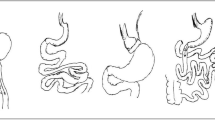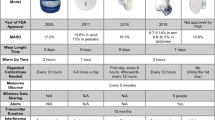Summary
Glucagon was administered exogenously via a subcutaneous route to totally depancreatized adult mongrel dogs and studies were made with major emphasis on glucagon effect on the plasma glucose levels.
-
1.
In the totally depancreatized dogs, the plasma glucose levels determined 90 minutes after glucagon injection (40µg/kg s.c.) were compared with the pretreatment fasting plasma glucose levels. The rate of increase in the plasma glucose levels was 5.13±0.48 times (M±SEM) in dogs with low pretreatment levels (lower than 100 mg/dl). In dogs with higher pretreatment levels (100–400mg/dl), the increase was 1.62±0.40 times. And in dogs with the pretreatment levels higher than 400mg/dl, the value was 0.90±.07 times.
-
2.
Ninety minutes after regular insulin injection (0.25U/kg i.v.), glucagon was administered (40/smg/kg s.c), and the changes in the plasma glucose levels were determined.
-
3.
In totally depancreatized dogs, a transient increase in the plasma insulin level was noted when glucagon was administered (40/smg/kg s.c.) under infusion of a mixture of glucose and insulin.
-
4.
There was no significant difference in the rate of disappearance of glucagon from the blood between normal and totally depancreatized dogs.
-
5.
It is considered that glucagon would be useful for the treatment of hypoglycemia encountered after total pancreatectomy.
Similar content being viewed by others
References
Colwell AR: Clinical use of insulin, in “Diabetes Mellitus”: Theory and Practice by Ellenbug MH, Rifkin. McGraw-Hill Book, 1970, p624
Ezdinili EZ, et al: Comparison of glucagon and epinephrine effects in dogs. Endocrinology 78: 47, 1966
Hagen JH: Effect of glucagon on the metabolism of adipose tissue. J Biol Chem 236: 1023, 1961
Samols E, et al: Promotion of insulin secretion by glucagon. Lancet 11: 415, 1965
Crockford PM, et al: Effect of glucagon on serum insulin, plasma glucose and free fatty acids in man. Metabolism 15 (2): 114, 1966
K Konishi, et al: Studies on sugar metabolism in totally depancreatized dogs with special reference to insulin metabolism. Arch Jap Chir 44 (6): 465, 1975
Norgaad A, et al: Clinical investigation into the effect of intravenous injection of insulin. Acta Med Scand 72: 492, 1929
Hyvärynen A, et al: Specific determination of blood glucose with otoluidine. Clin Chem Acta 7: 140, 1962
Malvano R, et al: Insulin radioimmunoassay: A comparison of the three methods. J Nucl Biol Med 18: 80, 1974
Unger RH, et al: Glucagon antibodies and an immunoassay for glucagon. J Clin Invest 40: 1280, 1961
Aguilar-Parada E, et al: Effects of starvation on plasma pancreatic glucagon in normal man. Diabetes 18: 717, 1969
Kibler RF, et al: Effects in man of the hyperglycemicglycogenolytic factor of the pancreas. Amer J Med 13: 647, 1952
Kibler RF, et al: Responsiveness to the pancreatic hyperglycemic glycogenolytic factor (HGF) as a test of liver function. Clin Res Proc 1: 109, 1953
Linke A: Klin Wschr 37: 876, 1959
Marble A, et al: Joslin’s Diabetes Mellitus, Lea & Febiger, Philadelphia, 1971, p 179
Hildes JA, et al: Liver and muscle glycogen in normal subjects, in diabetic mellitus and in actute hepatitis. Clin Sci 7: 287, 1949
Steiner DF, et al: Mechanismus of regulation of hepatic glycogen synthesis. Nature 204: 1171, 1964
Hajime Aoe, et al: Histochemical demonstration of human liver hexokinase using nitro-blue tetrazolium. Acta Histochem Cytochem 8: 1, 1975
Barka T, et al: Oxidative enzymes in histochemistry. Theory, practice and bibliography. Hoeber Medical Division, Harper and Row Publishers, New York, 1963, p 296
Wachstein M, et al: On the histochemical demonstration of glucose-6-phosphatase. J Histochem Cytochem 4: 592, 1956
Hajime Aoe: Histochemical demonstration of fructosel, 6-diphosphatase in rat liver using nitro-blue tetrazolium. Acta Histochem Cytochem 7: 184, 1974
Author information
Authors and Affiliations
Rights and permissions
About this article
Cite this article
Nishimura, I., Sudo, T., Konishi, K. et al. Effect of exogenously administered glucagon on plasma glucose levels in totally depancreatized dogs. Gastroenterol Jpn 13, 468–479 (1978). https://doi.org/10.1007/BF02774913
Received:
Accepted:
Issue Date:
DOI: https://doi.org/10.1007/BF02774913




